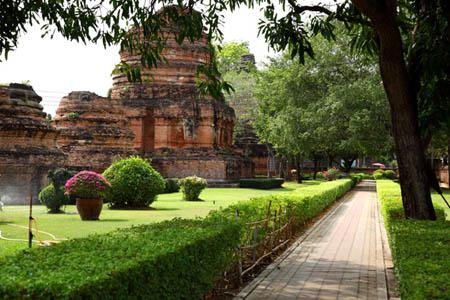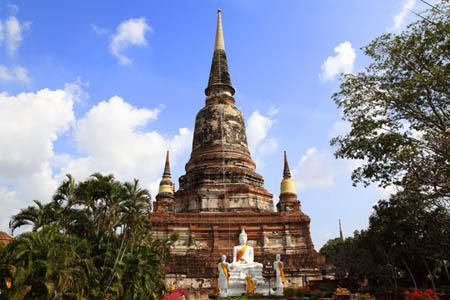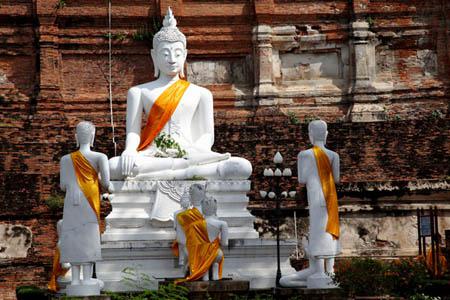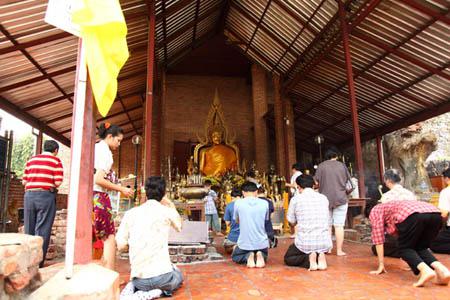Thailand - Ayutthaya 2 - Outside the island
 Ayutthaya is 80 km north of Bangkok. It's the ancient capital of Ayutthaya kingdom (1351 - 1767).
Ayutthaya is 80 km north of Bangkok. It's the ancient capital of Ayutthaya kingdom (1351 - 1767).The Ayuttaya city is surrounded by Chao Phraya river (Menam Chao Phraya) and its branches. The old buildings were destroyed because of a lot of fights with Burma during the Ayutthaya period.
This page shows "Outside the island" such as What Yai Chai Mongkol, Japanese village, Japanese town, and so on.
 |
|
| Ayutthaya City (Ayutthaya Historical Park) (The original file is from the Wikimedia Commons.) |
Ayuttaya on the map (80 km north of Bangkok) |
- Ayutthaya 1: Historical Park (Wat Mahathat, Wat Phra Si Sanphet and so on)
- Ayutthaya 3: Bang Pa-In Palace, House in old days, Sala Pra Ming Kwan
[Ayutthaya] Wat Yai Chai Mongkon |
|||
 Wat Yai Chai Mongkon, outside the Ayutthaya island, was built in 1357 by the King U-Tong.
Wat Yai Chai Mongkon, outside the Ayutthaya island, was built in 1357 by the King U-Tong.The huge and magnificent chedi and a lot of Buddha images around are overwhelming. ------------ Explanation board says; ------------This temple has a big Reclining Buddha image. It's not as big as the one in Wat Pho (Bangkok), still it's big ! |
|||

|

|

|

|
| Entrance 1 The entrance ! Now, let's go ! |
Entrance 2 Decoration of the gate of the entrance. |
Scenery around the entrance Some old buildings will come into view. |
Over there A big chedi can be seen over there. |

Reclining Buddha 1 |

|

|
|
| Reclining Buddha 2 Very big compared to visitors. |
Reclining Buddha 3 A lot of people come to pray. |
||

|

|
||
| Reclining Buddha 4 Feet of the Buddha image. Gold leaves cover them. |
Reclining Cat Reclining cat besides the Reclining Buddha. :D |
||

|

|
||
| The Chedi The Chedi has come to view. |
The frond There are stairs and you can go up. |
||

Upstairs |

|

|
|
| The front stairs Looking down from the front stairs. |
Upstairs of the chedi Upstairs of Chai Mongkol. |
||

|

|

|

|
| White Buddha Behind the huge chedi, a white Buddha image is enshrined. |
Another side Chedis on the another side also. |
Looking down Scenery looking down at the front. |
The front stairs The scenery of the front stairs. |

|

|
||
| The whole scenery of the chedi it's huge ! You must come here at least once. |
Buddha images in line I guess you've once seen this kind of pictures. Famous angle. |
||

|

|
||
| From behind The image from behind. |
White statues Looks like one scene where Buddha is teaching his students. |
||

|

|

|

|
| Main hall ? A image is enshrined and a lot of people come to pray. |
Skyblue TukTuk This colored tuktuks can be seen not so often. |
Flowers 1 Same as a rare four-leaf clover in Japan, if you find five-leaf flower, you will be very lucky. :D |
Flowers 2 There is a five-leaf flower in the picture. You'll be lucky ! :D |
[Ayutthaya] Japanese village (Ban Yipun) |
|||
| When I was a junior high school student, I learned about a Japanese who
did a great job in Thailand named " Nagamasa Yamada ". I'm wondering if students these days also learn it or not. :) This was the Japanese village related the Japanese, memorial site of the old Japanese settlement in Ayutthaya. |
|||

|

|

|

|
| The entrance (Entrance fee is 20 Bahts.) |
Monument and the atmosphere (Looks like a park inside the area.) |
||
 < Stone monument > It says like this:
< Stone monument > It says like this:Ayutthaya was the capital of Thailand for 417 years from 1350 to 1767. |
|||

|

|
||
| Map of Ayutthaya those days (Explanation with the picture: Water painting in "Ayutthaya, the capital of Siam", publish in Holland. From this painting, you can see that the traffic in Ayutthaya in those days were by channels. Japanese village at that time was outside of this map, bottom right.) |
Red seal ship (Left: Red seal ship, Suetsuguya-maru Bottom right: wooden plaque of battle ship) The middle: Head of a Buddha statue found in 1933 by a professor of Tokyo Metropolitan University) |
||

|

|

|

|
| Nagamasa Yamada (There is a gift and display corner here.) |
Lanthom (Known as "Pagoda flower" or "Wat flower" and called "Lanthom". These days, the name has been changed to "LeeLawadee" because "Lanthom" sounds "sorrow" in Thai.) |
Shaved ice shop (You can send some goods from here to Japan by a Japanese delivery service, Kuroneko Yamato. :D ) |
Big Japanese fan (Hand painted with fluorescent colours on velvet close. Trilogy of morning glow, evening glow and night. 1,350 Baht.) |

|

|

|
|
| Scenery of Menam Chao Phraya along the area of Japanese village (Boats are coming and going. The picture right is carrying sand.) |
|||
< Wat Panan Choeng: explanation board >
Wat Panan Choeng is an old monastery housing Thailand's largest ancient Buddha image, known as "Luang Po To". A historical chronicle states that this gilded stucco image was made in A.D.1334, some twenty-six (26) years before the establishment of Ayutthaya as the capital of the Thai Kingdom in A.D.1350.
Originally, the Buddha image was exposed to the elements of nature in accordance with Thai tradition where no covering structure was made over a large statue so that the magnificence of the image could well be admired from any angle as well as from any visible distance.
Chinese followers revere the Buddha image as their "Sum Po Hud Kong", or the god protector of those who sail, since much sailing was done by the Chinese then, for trade or for migration.
Though an old temple, Wat Panan Choeng has never been deserted by its followers. In fact, continuous development has been made thorough time, as evidenced by the existing landscape and Thai architectural structures omated by decorative art motifs attributed to different periods, side by side.
The interior and its facilities have constantly changed in adoption to time, to ease the process of worshipping and study.
It is also said that the beginnings of the temple is related to a love myth between a Thai Prince and a Chinese Princess of long ago.








